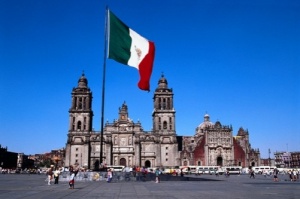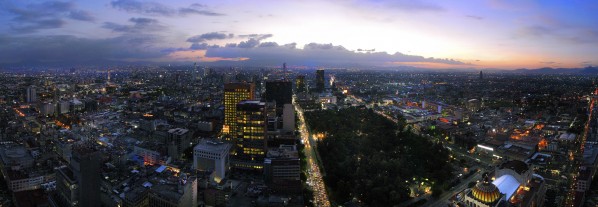A house divided against itself: Safety of tourism in Mexico

Mexico can consider itself lucky.
Things could be much worse. Just two years ago – at the height of the swine flu epidemic – visitor numbers fell by up to a quarter as holidaymakers from around the world decide to shorten, postpone or cancel trips.
While that disaster eventually claimed the country’s oldest airline - Compañía Mexicana de Aviación – the destination recovered quickly and has since been enjoying a remarkable renaissance.
Visitor numbers are buoyant approaching the end of 2011 and consumers are increasingly aware of what on is on offer in the country, from the beaches of Acapulco and Cancun in the east to the vibrant capital of Mexico City.
However, the black cloud in the otherwise blue sky is safety.
In this regard it is almost a case of two Mexicos.
While the capital – and tourist beaches in the west of the country – is considered safe, some northern provinces appear to be in a state of virtual civil war. Here rival drug cartels fight each other for control of distribution networks to the United States while the Mexican government seeks to quell the violence creating a bloody spiral.
As many as 20,000 lives have been lost in 2011 alone; with the figure perhaps double that over the past five years.

Mexico is presently celebrating the bicentenary of its independence from Spain
But that is to obscure the true nature of the country as a destination.
Mexico – and in particular Mexico City – is a thriving tourism market, rivaled only by the United States and Canada in the Americas.
Research from the World Travel & Tourism Council (WTTC) reveals the tourism sector accounts for some 13.2 per cent of the national economy.
The famous beach resorts of Cancun – a haven to millions of visiting Americans – and Acapulco are among the most popular in the world, while the cities of Guadalajara (home to tequila, mariachi and charros) and historic Morelia are also widely visited.
Central and southern parts of Mexico were also host to several pre-Hispanic civilisations, the most prominent of which are the Aztec, Mayan, and the Olmec. These Meso-American cultures have left a legacy of spectacular ruins which are popular with tourists.
Mexico City as a Tourist Destination
Mexico City is the centerpiece of the market.
Already a city of some 20 million inhabitants, the capital has seen ranks swelled over the past five years by an influx of residents from the northern provinces.
Most come out of concern for their safety elsewhere in the country, with the murder rate in Mexico City half that of the national average (and below comparable American cities, including Washington).
Credit for this relative safety is split between Marcelo Ebrard, the mayor of the central Federal District, and Mexico State governor Enrique Peña Nieto, both of whom are responsible for approximately half of the city’s residents.
Both are expected to run for president in 2012, with Ebrard arguing improved education and employment prospects have limited cartel recruitment, while Nieto argues attacks on the finances of drug traffickers are more useful.
It remains to be seen who the electorate will trust.
In the meantime, Mexico City has resumed its place as the premier tourism destination in the country, welcoming millions of visitors a year.
An ancient capital, the city presents a contemporary culture combining pre-Hispanic, colonial and modern influences that span nearly seven centuries.
It is also home to 160 museums, 31 distinct archeological and historic sites, as well as 100 art galleries, giving the city a European feel many compare to Barcelona.
“We welcome 12 million visitors to Mexico City each year, who come for our many historical and cultural sites, business conventions and world-class restaurants and hotels,” Mexico City mayor Marcelo Ebrard, told Breaking Travel News at FITA 2011.

Despite concerns over safety, Mexico City has emerged as a thriving destination
That is not to say there are not problems.
While officials at the British Foreign & Commonwealth Office (FCO) describe most visits to Mexico as “trouble free”, they do sound a note of caution.
The border town of Ciudad Juarez, for example, has seen a high level of drug-related violence and criminal activity taking it off limits to most visitors.
There has also been an increase in violence in the northern states of Chihuahua, Nuevo Leon and Tamaulipas, including in and around Monterrey, and the border areas of Nuevo Laredo, Reynosa, and in Tampico, adds the FCO.
The government body advises against “all but essential” land crossings between the United States and Mexico in Ciudad Juarez following an alert issued by the US Consulate in the city in July this year.
Continued Strength
That has not discouraged many holidaymakers, however, with the strength of the destination outweighing concerns over safety.
Indeed, tourism does not appear to be adversely impacted by drug violence.
In 2010 Mexico welcomed 22.3 million international visitors, an increase of 4.4 per cent on the previous year, according to the United Nations World Tourism Organisation.
Part of the recovery must be attributed to end of the adversely affects of the A(H1N1) influenza outbreak in 2009.
Nonetheless, figures increased despite an acknowledged spike in violence over the past 18 months in the northern regions of the country bordering the United States.
Mexico raised nearly $12 billion in tourism revenue last year and is the third biggest destination in the Americas – behind only the United States and Canada.
This does not sound like a country in the midst of a civil war.
Global leader Expedia also commented on the recent success of Mexico at the recent FITA 2011 industry conference.
“Mexico remains a favorite destination for our travelers worldwide, with over 1.5 million people booking travel to Mexico using Expedia websites in the last year,” said Marco Tagliatti, vice president of lodging supply, Latin America and Caribbean, Expedia.
“We continue to work closely with the Mexican tourism industry to promote travel to the country by travelers from around the world,” he told Breaking Travel News.

Over 20 million visitors will pass through Mexico this year
Looking Ahead
Mexico has problems to confront, just like any other.
The focus of efforts to curb violence has shifted to America, where officials are discussing ways of cutting demand for cocaine, potentially reducing violence in the country.
In the mid-term this could make the country safer to visit, removing one of the major barriers to growth in the tourism sector.
Meanwhile, the danger for the tourism industry, more than the cartels themselves, is a media narrative focusing on the drugs wars in the north at the expense of what is a thriving tourist destination.
Visitors to Mexico need to be aware of their safety, but they should be just as concerned scare stories could see them miss out this rapidly rising destination.

